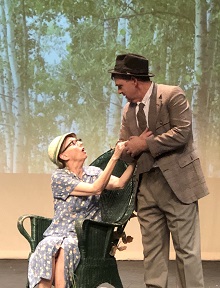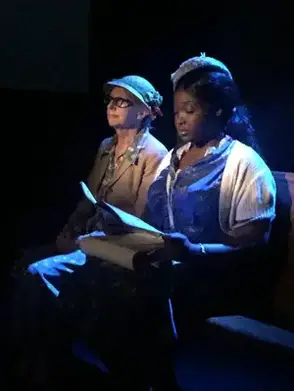Alumnae Theatre Company’s production (running April 8-23, 2022) is directed by Victoria Shepherd, who also gets a few Q&As. Interviewed March 30, 2022 by Alumnae’s Bloggergal/Bar co-manager Tina McCulloch.
Q (to Leslie McBay): In our last interview, you mentioned that you use a spreadsheet to track “moments of intimacy” that occur in a script, and found about 30 (“a fairly large number”) in “In the Next Room”!
Can you elaborate on a few that stand out for you?
A: One of the first moments that stands out to me is Mrs. Daldry’s first “treatment”, performed by Dr. Givings and assisted by Annie. This is the first time the audience sees what goes on inside the treatment room, and it’s all a surprise to Mrs. Daldry. It’s the first time she experiences an orgasm, and her experience of sexual pleasure grows and changes throughout the arc of the play. This is also where Annie is able to be a great comfort to Mrs. Daldry, and we see a momentary spark between them.

Photo: director Victoria Shepherd.
There’s a moment at the end of the first act where Mrs. Givings’ curiosity about what her husband is doing in the treatment room leads her to break into the room while he is out. She convinces Mrs. Daldry to explain the device to her, and demonstrate its function. In terms of character development, this is a great moment of intimacy where two women who have been deprived of knowledge about sexual pleasure and their own bodies are able to start exploring pleasure for themselves.
In the second act, we have a few moments of intimacy that show the disconnect and desire between Dr. and Mrs. Givings. We establish in the first act how they relate to each other physically, which always seems to leave Mrs. Givings wanting. In one of the scenes, Mrs. Givings persuades her husband to “treat” her with the vibrator. Dr. Givings wants to maintain his professional, almost paternalistic attitude, which is in conflict with his wife’s deep desire for intimacy, connection, and her newfound understanding of pleasure. I don’t want to give too much away, but the climax of the play hinges on whether or not they can find this connection with each other.

Q: I was surprised to learn that the electric vibrator was invented in the 1880s. Who knew? You both researched the historical vibrators described in the play – did you discover anything that surprised you? (Playwright Sarah Ruhl says she was “inspired” by a book titled “The Technology of Orgasm: ‘Hysteria’, The Vibrator, and Women’s Sexual Satisfaction” by Rachel P. Maines, published in 2001.)
A (Victoria): Prior to pitching for the show, I attended a session at Mackenzie House Museum called “Victorian Secrets”. Contrary to my belief that they were staid and uptight, the upper middle class and very wealthy were actually completely the opposite! Photographs of nude women in provocative poses and sexually explicit novels were not uncommon at all. It was the lower middle classes who lived and perpetuated the ideal of rigid morality and tightly-controlled sexuality. I was also surprised to find out that in order to control these impulses, a number of horrifying devices were available for sale, via catalogue, to control male erections and access to female sex organs. Turns out our ancestors were a little more awakened than we think!
A (Leslie): Definitely. Vibration seemed to be used as a treatment for other body parts like the spine and the intestines. I was surprised by a description of a steam-powered vibrator that required a separate room for the engine!
Q: How did you find out about the Mackenzie House session, Victoria?
A: When my kids were little, I took them on every outing available. I subscribed to the Toronto museums newsletter, found out about that session, knew I was pitching for the show and [“In The Next Room” set designer] Alexis [Chubb] and I went! I actually talked about some of the things I had learned in my pitch.
Bloggergal note: the Mackenzie House event “Victorian Secrets” (described in Toronto History Museums’ programming notes as “An interactive and intimate look at Victorian sexuality through an evocative evening event suitable for adults… Participants will be encouraged to be curious.”!!) took place in September 2019. “In The Next Room” was originally scheduled to run in April 2020, and rehearsals were underway when the theatre shut down for two years due to Covid. But now we’re baaaaack! These are the people who made it happen:

| Mrs. Catherine Givings | Rachelle Mazzilli | |
| Dr. Givings | Trevor Cartlidge | |
| Annie | Monique Danielle | |
| Mrs. Sabrina Daldry | Kim Croscup | |
| Mr. Dick Daldry | Ted Powers | |
| Elizabeth | Rée Andrews | |
| Leo Irving | Chris Peterson |
Director…………………………………………………………… Victoria Shepherd
Producers………………………………………… Ellen Green, Barbara Larose
Stage Manager…………………………………………………………. Victoria Stark
Asst Stage Manager……………………………………… Polina Zlochevskaia
Costume Design…………………………………………………….. Livia Pravato
Set Design…………………………………………………………….. Alexis Chubb
Lighting Design …………………………………………………….. Liam Stewart
Music / Sound Design………………………………….. John Stuart Campbell
Vocals………………………………………………………….……….Vivien Shepherd
Intimacy Director…………………………………………………… Leslie McBay
Master Carpenter…………………………………………………. Brent Shepherd
Sound / Lighting Operators……………………………….. Giovanna Varsano
Costume Team……….. Adrienne Winterhelt, Marcella Pravato, Emily
Colucci, Kathleen Winterhelt (Hair, Wigs)
Properties………………………………………………………………………… Tamsine Ali
Stunt Portrait Artist………………………………………. Alyssa Quart Cartlidge
Marketing Director…………………………………………………………….. Kat Welsh
Graphic Design…………………………………………………….. Suzanne Courtney
Website…………………………………………………………………………. Jean Sheppard
Season Front of House Manager………………………………….. Alison Smith
Reservations Manager…………………………………………………… Krystina Hunt
Photographer………………………………………………………………. John Ordean
Videographer……………………….………………..……………………… Matt Jensen
Alumnae Theatre Company’s production of
Sarah Ruhl’s “In The Next Room, or The Vibrator Play”
directed by Victoria Shepherd
runs April 8 – 23, 2022.
Performances Wed – Sat at 8pm • Sundays at 2pm.
Regular tickets $25 • Wednesdays 2 for 1 • Sundays PWYC.Purchase: https://www.alumnaetheatre.com/in-the-next-room-or-the-vibrator-play.html














 Chris Coculuzzi & Erik Mrakovcic. Set design by Teodoro Dragonieri. Costume design by Margaret Spence. Lighting design by Liam Stewart. Photo by Bruce Peters.
Chris Coculuzzi & Erik Mrakovcic. Set design by Teodoro Dragonieri. Costume design by Margaret Spence. Lighting design by Liam Stewart. Photo by Bruce Peters. Lindsay Sutherland Boal. Set design by Teodoro Dragonieri. Costume design by Adriana DeAngelis. Lighting design by Liam Stewart. Photo by Nicholas Porteous.
Lindsay Sutherland Boal. Set design by Teodoro Dragonieri. Costume design by Adriana DeAngelis. Lighting design by Liam Stewart. Photo by Nicholas Porteous.


 mnae Theatre Company opened its 102nd season with Wendy Wasserstein‘s Pulitzer Prize-winning
mnae Theatre Company opened its 102nd season with Wendy Wasserstein‘s Pulitzer Prize-winning 
